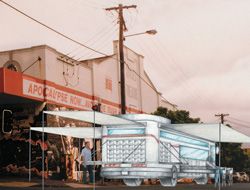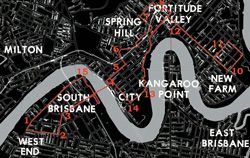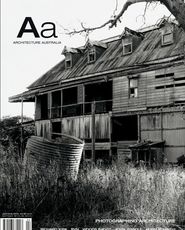THE ASIA/OCEANIA SECTION OF THE UIA’S CELEBRATION OF CITIES COMPETITION WAS WON BY A TEAM FROM KEVIN HAYES ARCHITECTS. PAULA WHITMAN CONSIDERS THEIR MOBILE PROPOSAL FOR ALLEVIATING THE PROBLEMS OF HOMELESSNESS.

Kevin Hayes Architects’ winning entry envisages MOBSTAs catering to the homeless all over Brisbane.

The refitted buses will be a safe place to shower, eat, see a doctor, sleep and socialize.

MOBSTAs will provide free travel during the day and become hostels at night.

The proposed route.
THE UIA IDEAS COMPETITION, A Celebration of Cities, required entrants to define a particular problem facing cities today and to make proposals to address that problem.
MOBilSTAtion – or MOBSTA – from the Brisbane practice Kevin Hayes Architects was recently awarded first prize in the Asia/Oceania Region of the competition. The problem identified was the growth of the homeless population within the inner city and the provision of services to this marginalized group. One of the negative consequences of inner city urban renewal – to which the Kevin Hayes practice is an acknowledged and award-winning contributor – is the growth of homelessness. This is an oversimplification of the societal forces at play. Yet it could be argued that as the stock of older, affordable housing and derelict buildings and sites are replaced by up-market developments, people dwelling in these places are simply moved out and moved on. Despite the challenges and sensitivities of dealing with the homeless as a client group, the Hayes team felt that homelessness was a problem that needed to be addressed in a responsible and creative way by the architectural profession.
The UIA were particularly interested in identifying “real actions” that could be implemented through partnerships with authorities and city councils. The Hayes team saw an opportunity to work with the Brisbane City Council (BCC) by using redundant BCC buses, fitted out with facilities aimed to meet the needs of the homeless, within the city. The proposal envisages a fleet of mobile stations or MOBSTAs travelling along a set route, connecting places of significance for the homeless, such as existing hostels and other public services.
The refitted buses would make available some of the essentials that might otherwise be difficult for the homeless to access – a place to shower, a safe place to sleep and somewhere to temporarily store their possessions. Information and professional advice would also be available. By day MOBSTAs would provide a means of transport throughout the city. By night they would park in designated areas, becoming temporary hostels. They would act as mobile resources and community centres for those commonly excluded from the community.
The proposal builds on a well-tested method of providing services to the homeless – the mobile facility. The street van, run by a range of volunteer groups, is a common sight within the modern city, dispensing food and beverages to the homeless. The MOBSTA builds on this precedent by offering an increased range of services. The strategy of extending an existing service, rather than promoting a new type of facility for the homeless, is a sound one – a service familiar in at least some of its details is more likely to be accepted.
The decision to address the problem of homelessness with a mobile service, in preference to a fixed resource, acknowledges the reality that facilities for the disadvantaged are not popular additions to a neighbourhood, including the inner city area which might be considered the natural habitat of the homeless. This unpopularity is little more than a case of the “nimby” or “not in my back yard” phenomenon, as residents fear that property values will plummet due to the presence of an undesirable element. A recent exercise in the provision of facilities for the homeless in New Farm Park, a large public open space on the edge of Brisbane’s riverside urban renewal precinct, fell foul to such a response. The New Farm Park facilities, which included shower and toilet amenities and sleeping areas, were closed down after a very short trial period, due to the somewhat negative response from the local residents. In making the MOBSTA mobile, the permanent threat to property values is neutralized. While the MOBSTA avoids the centralization of facilities for the homeless, it does not attempt to hide their existence. Rather, one of the project’s major objectives is to raise public awareness through the sheer visibility of the MOBSTAs travelling through the city.
In their competition entry, the Hayes team propose a second stage to the project, where the MOBSTAs act as mobile service cores, providing water and power to otherwise uninhabitable derelict buildings all over the city. In considering this second stage, the team were influenced by the work of a United Kingdom organization, Crash, a construction and property industry charity for the homeless that brings together professionals and companies to help homelessness charities improve their premises. The aim is to make derelict buildings habitable through the provision of basic services and minimal building improvements. (Similar ideas are also being developed in a Crash programme in Sydney.) In stage two of the competition scheme, the MOBSTA becomes the focus for this type of minimal, remedial work.
Architects are attracted to ideas competitions such as the UIA Celebration of Cities as they are an invitation to speculate freely; it is the implementation of those speculations that is always the challenge. The Hayes team recognize the difficulties of making MOBSTA work.
Who would meet the initial start up expenses and the ongoing running costs? Who would be responsible for the staffing and management of the fleet? How would MOBSTA work in with other existing mobile services who are somewhat protective of their existing turf? They say that for every complex problem, there is a simple solution – and that it is usually wrong. Is the MOBSTA too simple a solution for the complex problem of homelessness? Possibly, but the team at Kevin Hayes remain enthusiastic to see the ideas through to implementation. They recognize that “the homeless” should not be characterized as a homogeneous group, and that proposals such as the MOBSTA might in the end meet only some of the needs of the people involved. If MOBSTA were to be developed, there would need to be further close consultation with many groups, the most important of which would be “the homeless” themselves. Only then could a proper assessment of the efficacy of the project be made.
DR PAULA WHITMAN IS A SENIOR LECTURER AT QUEENSLAND UNIVERSITY OF TECHNOLOGY AND THE PRESIDENT OF THE RAIA QUEENSLAND CHAPTER.















